
Fundraising Email Template: More Opens, Clicks, and Donors
As more and more donors shift to online giving, email fundraising becomes increasingly important for nonprofits that want to keep earning attention and support in the future.
But you’ve probably found that sitting down to write an effective fundraising email isn’t as easy as it sounds: What should you say? How should it look? Who should the sender be?
Luckily, you don’t have to guess. This easy-to-use fundraising email template is designed to help nonprofit organizations write more engaging emails and press send with confidence.
It’s based on the learnings from over 7,000 fundraising a/b tests and over a decade of helping nonprofits improve their fundraising and development using email marketing.
And to help you get the most out of the template linked above, this article will break down 7 key elements that make engaging, persuasive, and effective fundraising emails.
These element all work together to help donors understand your value proposition. In other words, they answer this core question: “Why should I give to you, rather than some other organization, or not at all?”
Let’s take a closer look at each of these elements so that you can press send with confidence and keep your mission moving forward!
The 7 key elements of an effective fundraising email:
- Send your fundraising email from a human. People give to people. Don’t send from the name of your organization.
- Nail your subject line. Before a donor can click a link or make a donation, they have to open your email. Spend time on your subject line and write it first
- Don’t customize your preview text. Custom preview text tells your donor that your email is marketing. Let your preview text naturally pull in the first line of your email.
- Say hello and call your donor by name. Your email should be written in a conversational tone – like a message to a friend or coworker. Good conversations start with a warm greeting.
- Explain the problem at hand. If there’s no problem to be solved, there is no reason to donate. Explain what the problem is and the symptoms your donor experiences or could experience as a result.
- Propose a solution. Help your donor catch the vision for solving the problem at hand
- Articulate the donor’s impact. Help your donor connect their donation to meaningful impact. Be clear, articulate, and don’t be afraid to write a few paragraphs of copy.
Now let’s dive into the details so you can walk away ready to confidently apply each step.
1. Send your fundraising email from a human
People give to people, so plan to send your emails from humans within your organization rather than your organization itself. And don’t be afraid to test new senders for your fundraising emails — although should use this strategy sparingly.
In the email fundraising experiment shown below, an organization changed their sender name from the name of the organization to an actual person.
They also revamped the subject line and email copy to reflect the human-nature of the email.
The result? A 330% increase in email opens and a 7x increase in conversions.
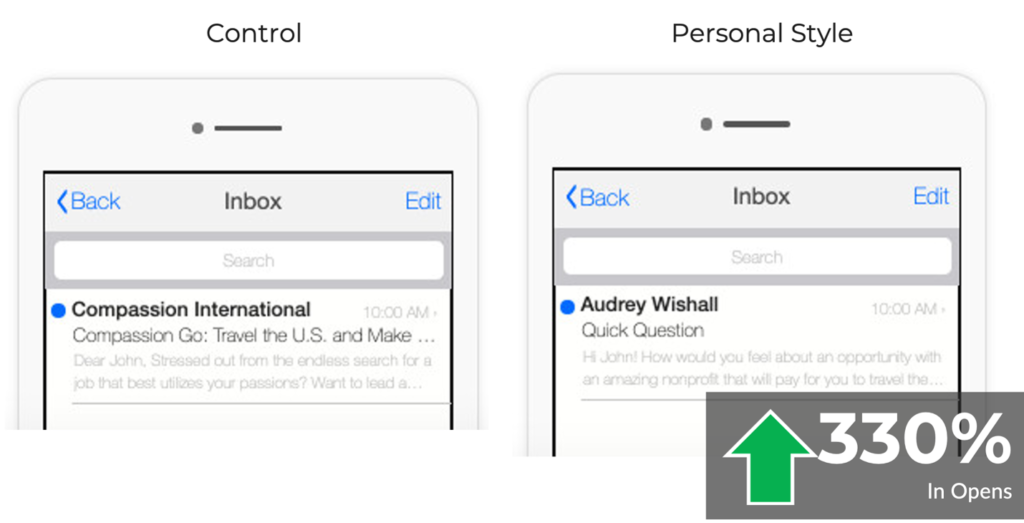
2. Spend more time on your subject line
Before a donor can click a link and make a donation, they have to open your email.
Think of your subject line as the headline of your email — how you stand out in an increasingly crowded inbox — and the first step of the donation process as a whole:
Before someone can make a donation, they have to click your call to action.
Before they click your call to action, they have to read your copy.
But before they read your copy, it’s your subject line that has to do the work.
And there is a significant opportunity here — you’ve probably noticed that most subject lines from nonprofit organizations sound similar.
This is your chance to stand out by doing something! And just like products, you should lean into differentiation to set yourselves apart — after all, you’re competing against them for attention too!
Try using mystery in your subject lines.
Mix things up and always a/b test your ideas so you know the impact of your changes.
And if you want more idea for writing subject lines that engage your ideal donor, click here for our in-depth, how-to on writing better fundraising emails subject lines.
3. Don’t customize your preview text
Your preview text is the first glimpse a donor gets at the actual content of your email.
Many fundraisers customize this text to make it sound more appealing. Sometimes, they even try to ask for a donation in the preview text.
However, customizing your preview text tells donors that your email is not intended to be a personal communication.
Instead, custom preview text tells donors they’re being sold to. And people don’t want to be sold to — they want to be communicated with personally.
Let your preview text show the first line or two of your actual email. This will appear in their inbox just like any other email from a friend, family member, or colleague.
In one fundraising experiment, we wondered if customizing the preview text to showcase the core content of the email would lead to higher open rates.
But instead, customizing the preview text led to a 9% decrease in opens.
4. Say hello and call your donor by name
Begin your email copy by saying hello and using your donor’s name. This might sound overly simplistic, but the implications are profound.
Since people give to people, you’ll want to start your email off like a conversation. Be friendly. Be authentic. You might use a warm greeting or conversational language such as:
- Hope you’re doing well.
- Thought you’d find this valuable.
- I knew you’d want to know about this.
This can lower your donor’s defenses and will set a personal tone for the rest of your fundraising email.
In one fundraising email experiment, a nonprofit tested making a simple change to their email by adding a personal salutation to the beginning of the email.
This one small change led to a 270% increase in clickthrough rates.
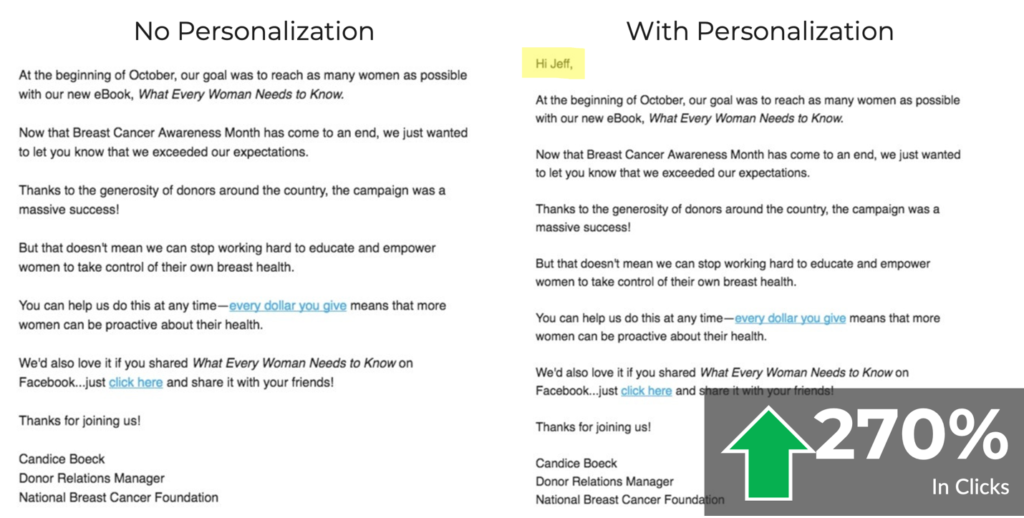
5. Explain the problem at hand
After your greeting, you’ll want to clearly lay out the reason for sending your email. The primary way to do so is to explain the problem at hand.
Generally speaking, this is the core reason your organization exists. It’s the reason you’re asking for funds in the first place. It’s the overarching reason why donors give to you, and why your email subscribers follow you.
If there is no problem to solve, there is no reason to give.
Spend as much time as you need help donors understand the problem at hand. You might need 2-3 paragraphs to do this well.
Here’s a powerful example that lays out a very clear and thought-provoking problem:
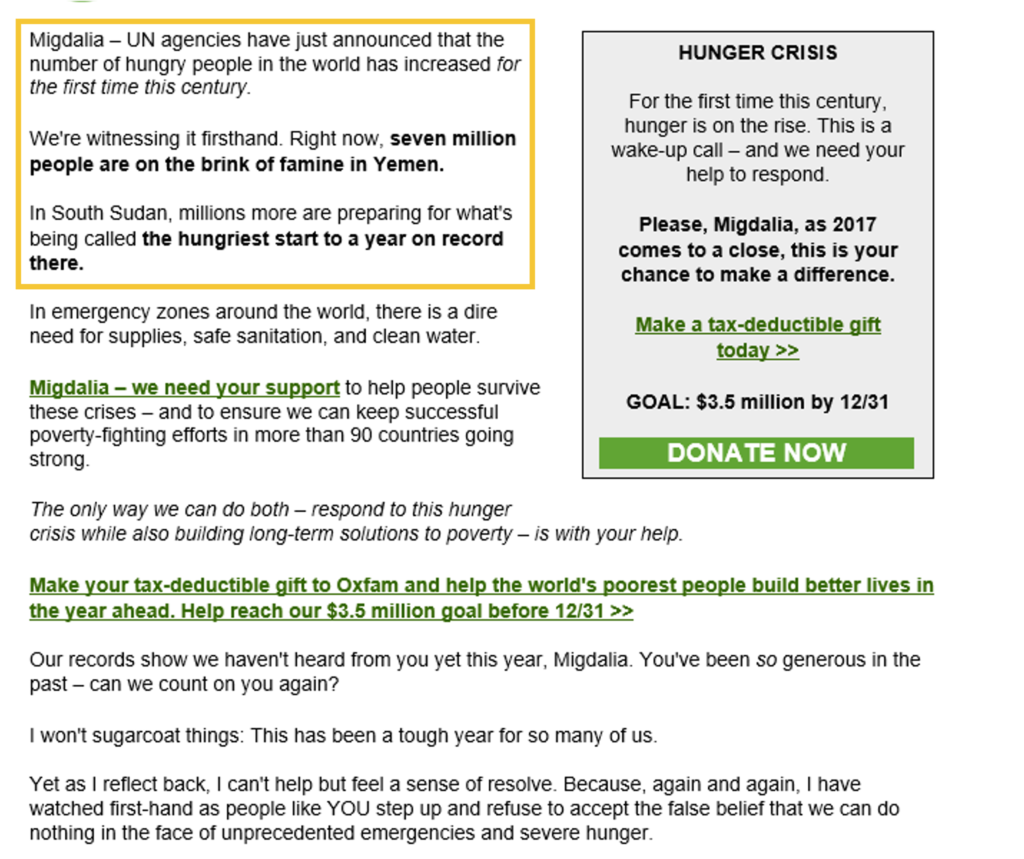
6. Propose a solution (and an outcome)
Now that you’ve articulated the problem, what is the solution? Use the next section of your email to cast the vision for a solution.
If you have a very far-reaching or broad cause, you may have a very bold and big solution. It’s possible you’ll need significant copy to explain your solution and how it will make a difference.
If your cause is simpler in nature, you might need just a sentence or two to explain what can be done to solve the problem at hand.
In this email fundraising experiment, a nonprofit tested taking more of a direct approach to their fundraising email appeal would lead to greater giving.
They present a clear problem and a clear solution. And they position the donor’s voice as that solution.
The result? The direct appeal outperformed the soft-donation ask and increased donations by 246%.
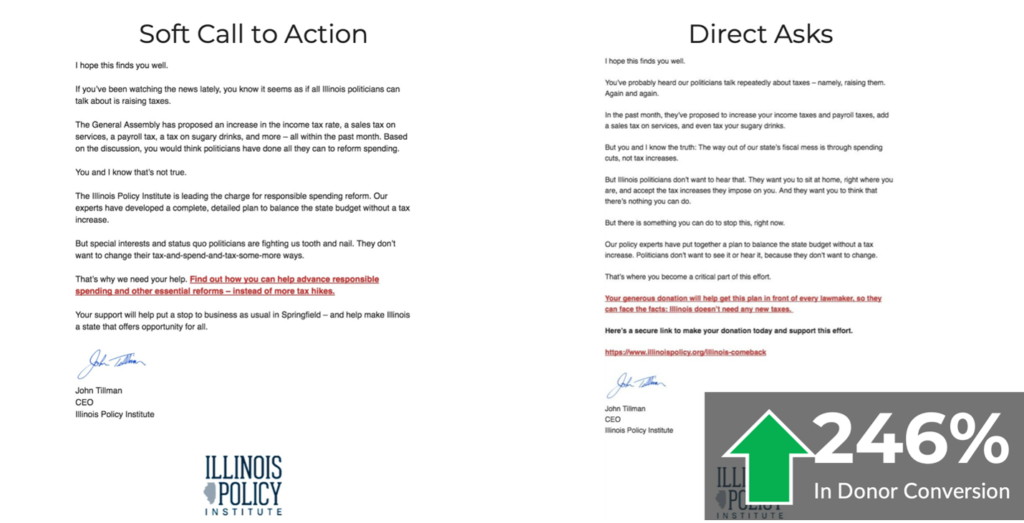
7. Articulate the donor’s impact
Of all the elements presented in this guide, this may be the most critical.
If you want to see a significant response to your fundraising emails, your donor must understand the impact of their support.
Use plenty of copy to help answer key questions your donors may have:
-
- Who will my donation impact?
- What will it do for them?
- What kinds of programs or services does my gift fund?
- How quickly will my donation be put to use?
- Exactly how will my donation be used?
You may even consider using “gift handles” to explain what certain dollar amounts will accomplish. For example: $50 feeds a family for a month; $100 feeds a family for 2 months; etc.
In this online fundraising experiment, a nonprofit tested using story to demonstrate impact to prospective donors.
The result? This story-driven approach led to a 52% increase in donations.
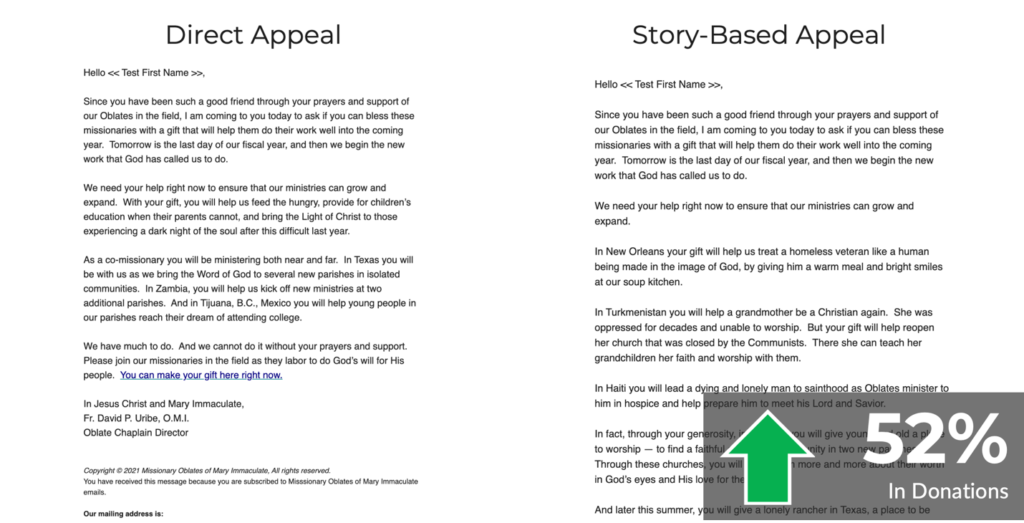
Conclusion
To write better fundraising emails, focus on improving these 7 key elements:
- Send your year-end fundraising email from a human.
- Nail your subject line (and write it first).
- Don’t customize your preview text.
- Say hello and call your donor by name.
- Explain the problem at hand.
- Propose a solution (and an outcome).
- Articulate the donor’s impact.
Nathan Hill is Vice President, NextAfter Institute.


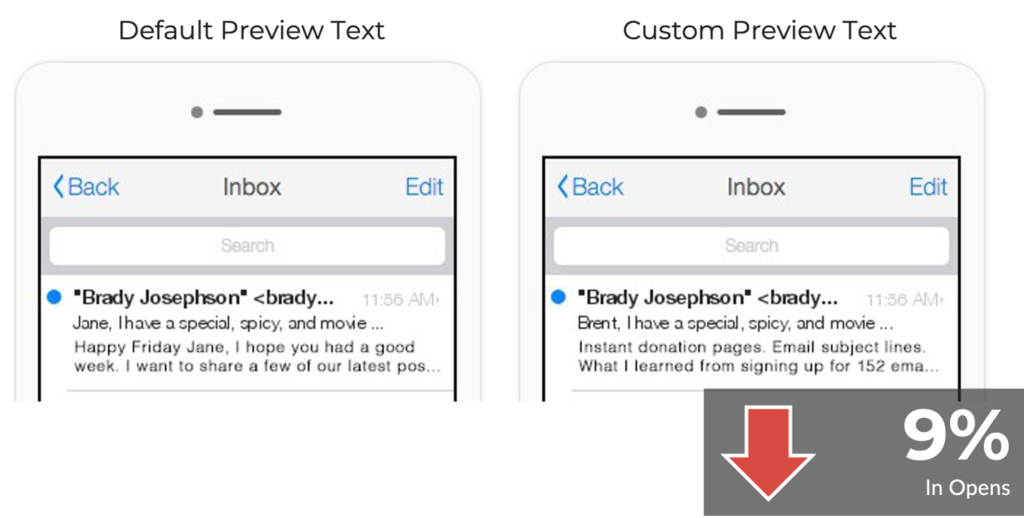

Thanks for this incredible information,
I must start using this email system.
Amazing tips! Helpful and timely for everyone, thanks for writing. I want to share a company that helped me sort out my community duties and build my club. “Community Club Victoria“. They understand club needs and provide support and advice to club networks. Once again, thank you.